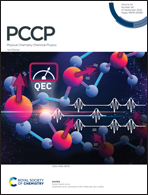Using metal substrates to enhance the reactivity of graphene towards Diels–Alder reactions†
Abstract
The Diels–Alder (DA) reaction, a classic cycloaddition reaction involving a diene and a dienophile to form a cyclohexene, is among the most versatile organic reactions. Theories have predicted thermodynamically unfavorable DA reactions on pristine graphene owing to its low chemical reactivity. We hypothesized that metals like Ni could enhance the reactivity of graphene towards DA reactions through charge transfer. The results indeed showed that metal substrates enhanced the reactivity of graphene in the DA reactions with a diene, 2,3-dimethoxy butadiene (DMBD), and a dienophile, maleic anhydride (MAH), with the activity enhancement in the order of Ni > Cu, and both are more reactive than graphene supported on silicon wafer. The rate constants were estimated to be two times higher for graphene supported on Ni than on silicon wafer. The computational results support the experimentally obtained rate trend of Ni > Cu, both predicted to be greater than unsupported graphene, which is explained by the enhanced graphene–substrate interaction reflected in charge transfer effects with the strongly interacting Ni. This study opens up a new avenue for enhancing the chemical reactivity of pristine graphene through substrate selection.

- This article is part of the themed collection: 2022 PCCP HOT Articles


 Please wait while we load your content...
Please wait while we load your content...
